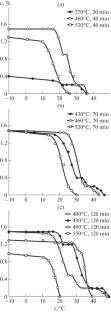时效方式对Ti-55.6Ni合金形状记忆效应特性的影响
IF 0.3
Q4 METALLURGY & METALLURGICAL ENGINEERING
引用次数: 0
摘要
摘要:研究了370 ~ 550℃时效条件对Ti-55.6Ni合金(wt %)反马氏体相变阶段和单向形状记忆效应变形-温度特性的影响。试验方法依据ASTM F2082标准。时效试样马氏体相变阶段的变化、恢复变形的增加和形状恢复温度的升高与Ti3Ni4相的释放有关,Ti3Ni4相的释放使镍的b2相耗损,微应力水平升高。在400 ~ 460℃时效时,形状恢复温度的最大升高(高达45 ~ 50℃)。本文章由计算机程序翻译,如有差异,请以英文原文为准。

Influence of Aging Modes on Characteristics of the Shape Memory Effect of Ti–55.6Ni Alloy
Abstract—The effect of aging conditions at temperatures 370 to 550°C on reverse martensitic transformation stages and deformation-temperature characteristics of the one-way shape memory effect for a Ti–55.6Ni alloy (wt %) has been investigated. The test method was based on the ASTM F2082 standard. The variation martensitic transformation stages, increased recovered deformation, and increased shape recovery temperature in aged specimens are shown to be associated with the release of the Ti3Ni4 phase, which depleted the B2-phase of nickel and increased the level of microstresses. The maximum rise in shape recovery temperatures (up to 45–50°C) results from aging at 400 to 460°C.
求助全文
通过发布文献求助,成功后即可免费获取论文全文。
去求助
来源期刊

Russian Metallurgy (Metally)
METALLURGY & METALLURGICAL ENGINEERING-
CiteScore
0.70
自引率
25.00%
发文量
140
期刊介绍:
Russian Metallurgy (Metally) publishes results of original experimental and theoretical research in the form of reviews and regular articles devoted to topical problems of metallurgy, physical metallurgy, and treatment of ferrous, nonferrous, rare, and other metals and alloys, intermetallic compounds, and metallic composite materials. The journal focuses on physicochemical properties of metallurgical materials (ores, slags, matters, and melts of metals and alloys); physicochemical processes (thermodynamics and kinetics of pyrometallurgical, hydrometallurgical, electrochemical, and other processes); theoretical metallurgy; metal forming; thermoplastic and thermochemical treatment; computation and experimental determination of phase diagrams and thermokinetic diagrams; mechanisms and kinetics of phase transitions in metallic materials; relations between the chemical composition, phase and structural states of materials and their physicochemical and service properties; interaction between metallic materials and external media; and effects of radiation on these materials.
 求助内容:
求助内容: 应助结果提醒方式:
应助结果提醒方式:


